US Pharm. 2010;35(8):8.
In 2008, the CDC announced that 56,300 people were newly infected with HIV in 2006, and that the epidemic has been worse than the predicted 40,000 infections per year. According to HIV surveillance data, more than 1 million people in the United States have HIV, and 1 in 5 is unaware of being infected.

African Americans constitute 12% of the population, but represent 45% of those newly infected with HIV; Hispanics/Latinos account for 15% of the population and constitute 17% of those newly infected. Within each racial/ethnic category are individuals with different risk factors for HIV infection, such as injection drug users and men and women who have sex with others at high risk for HIV infection.
Transmission Category: White, African American, and Hispanic/Latino men who have sex with men (MSM) represent 53% of new HIV infections, even though gay and bisexual men make up a very small portion of the population. MSM account for almost 25% of all new HIV infections--more than any other group. Forty-six percent, 35%, and 19% of new HIV infections occurred among white, African American, and Hispanic MSM, respectively. Among MSM, there were more new HIV infections in young (13-29 years) African Americans than in any other age or racial group. Among African American and Hispanic/Latino MSM, most new HIV infections occurred in the youngest age group. Among white MSM, however, most new infections occurred in those aged 30 to 39 years.
Injection Drug Users: HIV infection is on the rise in this population. This category accounted for 12% of all new HIV infections. Of these, 53% of cases were in African Americans, 30% in whites, and 17% in Hispanics/Latinos. In Hispanic/Latino newly infected injection drug users, males accounted for 65% of cases. Of the 6,610 newly infected injection drug users, 33% were among whites, with males and females sharing almost equally in the burden; more than half (3,480) were African American, with males accounting for 58% of new infections and females accounting for 42%.
Commentary: The alarming number of new infections among young African American, Hispanic/Latino, and white MSM underscores the importance of ensuring that each generation has the knowledge and skills to prevent HIV infection, beginning at a young age. The practicing pharmacist is in an ideal position to disseminate relevant information in this regard. The high incidence of HIV among gay and bisexual men in the middle age groups (30-39 years and 40-49 years) highlights the importance of programs that keep MSM HIV-free throughout their lives.
To comment on this article, contact rdavidson@uspharmacist.com.





